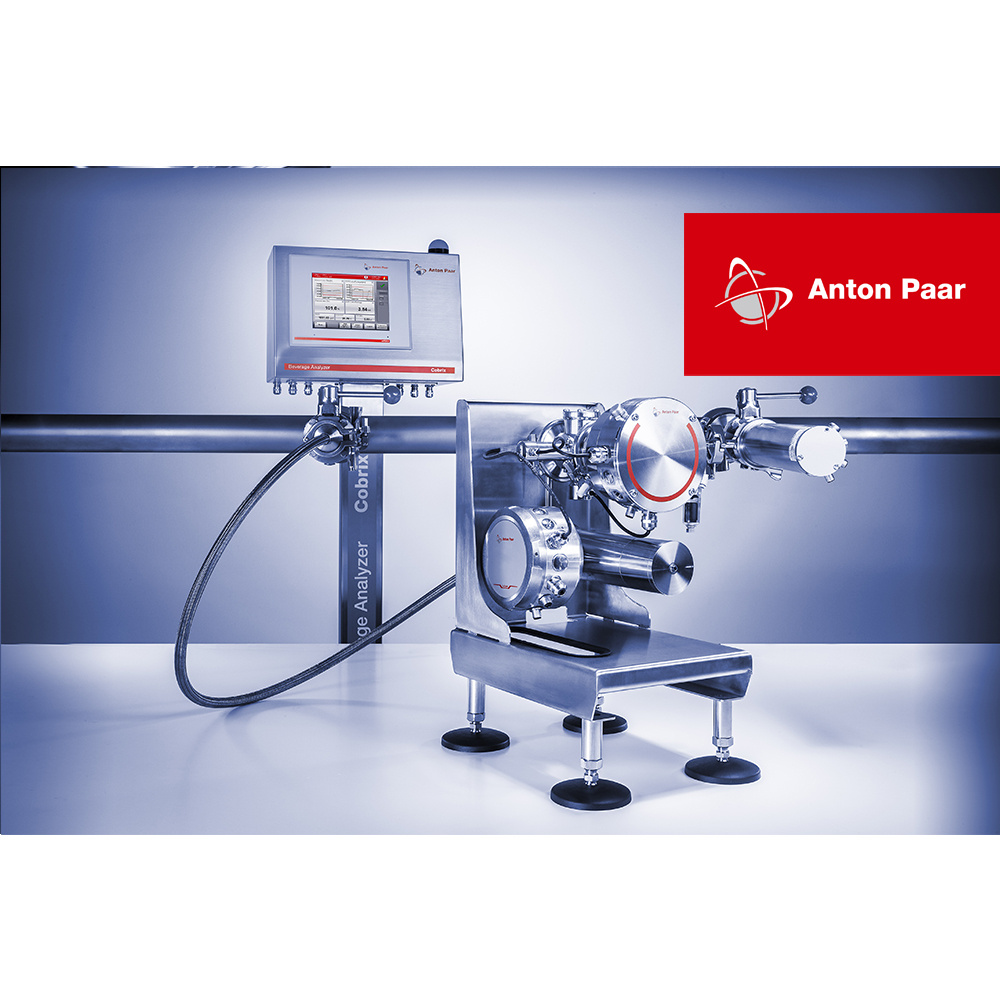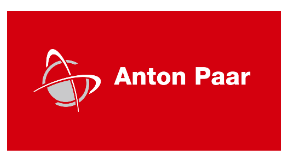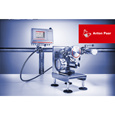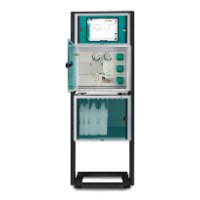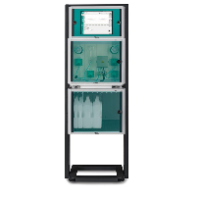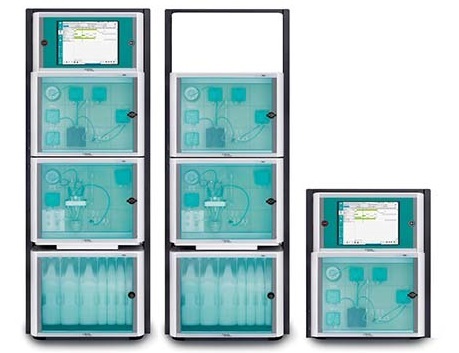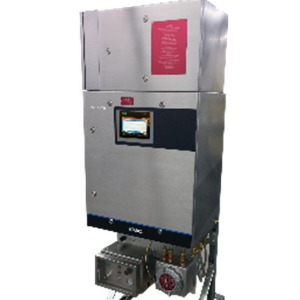Anton Paar是饮料分析的市场领导者,并提供在线,在线以及实验室葡萄酒分析解决方案。 高端技术与全球服务相结合,可提供完美的饮料分析-从葡萄等原材料到必须的瓶装葡萄酒,再到容易装瓶的葡萄酒产品,都能使消费者不断获得满意的满意度。这就要求红酒需要经过非常严格的品质把控,而安东帕的仪器恰好为红酒生产的质量监控提供了完美的解决方案。
方案详情

1 3 Complete your wine analysis Relevant for: Wineries, wine analysis laboratories, fillers and bottlers of wine Anton Paar is the market leader in beverage analysis and provides solutions for inline, at-line aswell as laboratory wine analysis. High end technology meets global service for the perfectbeverage analysis -from incoming raw materials such as grapes through must to readily bottledwine products for continuous consumer satisfaction. Table of contents 1 Raw material: Grape maturity 2 Raw material: Destemming and crushing 3 Must: Must enrichment 4 Must: Maceration (red wine process) 5 Must: Pressing (white wine process) 6 Must: Fermentation 7 Wine: Clarification and stabilization 8 Wine: Maturation and storage 9 Wine: Carbonation 10 Wine: Blending and Bottling Raw material: Grape maturity Figure 1 Grape maturity tests during ripening Wine making starts in the vineyard. Grape maturitytests are essential to determine the right time forharvest. 1.1 Challenges The grape passes various stages of developmentduring ripening - at the peak of this development, thegrapes are sweet with low levels of acidity, filled withjuice and not affected by mold or rot. It is essential forevery winemaker to harvest the grapes when they areat the peak of ripeness. However, the right time forharvest is different every year and changes with theweather and environmental conditions which influencethe grape vines. Therefore maturity tests arenecessary every year 1.2 How Anton Paar can help you overcomethose challenges Measuring relevant parameters during ripeningseason with Anton Paar instrumentation helps todetermine the ideal time for harvest and to get rawmaterial of best quality. Sugar content or must weight (°Brix, °Baume,°Oechsle), acidity and pH play an important role indetermining the maturity of grapes. The sugar content is the most important parameter tomonitor. It increases during ripening and grapes withhigh sugar content will yield high alcohol content afterfermentation. Malic and tartaric acid decrease during ripeningresulting in an increasing pH value. Low levels ofacidity are desirable, but lack of acidity makes thegrapes more vulnerable to mold and other spoilage;therefore malic and tartaric acid and pH value need tobe monitored tightly. The progress of those parameters is highly dependenton the grape variety itself and weather conditions.Cool nights and higher precipitation will result in highlevels of acidity paired with lower levels of sugar,while high temperatures result in high concentrationsof sugar. Determination of the right time for harvest calls forprecise analysis of the essential parameters as wellas expertise in the vineyard. 1.3 Benefits Fast determination of grape development stage Optimization of harvesting time High-quality raw material 1.4 Lab and At-line instruments Density (must weight): DMA 35 Refractive Index (°Brix): Abbemat 300 Titratable acidity, malic acid, tartaric acid, pH,glucose, fructose, must weight: Lyza 5000 Wine 2 Raw material: Destemming and crushing Quick but gentle processing of the raw material has tobe ensured. Monitoring key parameters indicates anefficient production step. 2.1 Challenges When the grapes are harvested at the ideal time ofripening, most grapes will contain high sugar levelsand low acidity. However, the ripeness of grapes canvary a lot even in a single vineyard. Thereforeextreme care needs to be taken to select only the bestgrapes. Unripe grapes or grapes contaminated withmold need to be removed meticulously. Especially the processing of harvested grapes needsto be done effectively but gently. In general, the rawmaterial should be processed immediately to avoidundesirable microbiological developments. Grapes are harvested with their stems. The firstproduction step for most wine styles is to destem thegrapes, while the individual berries need to stay intactso that they do not loose juice at this stage. If thestems are not removed completely, bitter flavors candiffuse into the must. Finally the grapes are crushed, grape juice is releasedfrom the grapes This mixture of juice and skin is calledmash. For red wine, grape skins will stay with the juicefor extended periods of time. 2.2 How Anton Paar can help you overcomethose challenges The quality of a finished wine is directly depending onthe quality and character of the harvested grapes.Vinification cannot improve the quality level, it canonly try to hold this level and bring out certaincharacteristics of the wine. Raw material monitoring after harvest and aftercrushing can give a lot of information on the quality ofthe raw material. Fast measurements of sugarconcentration and acidity levels by Anton Paarequipment help to take quick decisions during thesefirst production steps. When the characteristics (sugar content, acid profile,Yeast Assimilable Nitrogen YAN) of the raw materialare known, production steps can be adjustedaccordingly to intensify certain qualities of the rawmaterial. 2.3 Benefits Use only raw materials which meet yourstandards m Make sure the final product quality isguaranteed right from the beginning m Improve cost-effectiveness by avoiding faultybatches 2.4 Lab and At-line instruments: Refractive index (°Brix): Abbemat 350 Density (must weight): DMA 35, DMA 4500M Fructose, Glucose: Lyza 5000 Wine Titratable acidity, malic acid, tartaric acid, pH,YAN: Lyza 5000 Wine 2.5 On-line/In-line instruments Refractive index (°Brix): L-Rix 5100 or 5200 Density (°Brix): L-Dens 7400 Must: Must enrichment Figure 5 Must enrichment or chaptalization Must enrichment can help to overcome low sugarlevels of grape must, and is used mostly in cold-climate regions whereas acidification is common inwarm climates. 3.1 Challenges Addition of sugar or concentrated grape must tounfermented must is called enrichment, orchaptalization. The intend behind this process is toincrease the sugar concentration in order to yieldhigher alcohol levels after alcoholic fermentation. Withhigher alcohol levels, more flavor and aroma isproduced during the fermentation as well. Must enrichment is done mostly by adding canesugar, although other types of sugar may be useddepending on local regulations. Another way of mustenrichment is to add concentrated must or rectifiedconcentrated grape must to grape juice. In hot climates sugar levels are usually high but acidlevels are below a desired limit; therefore the pHvalues are decreased by acidification with tartaric orcitric acid. Addition of sugar and other substances is stronglyregulated by law. Each region has different rules andlimits for the amount of added sugar, for the achievedethanol concentration and allows addition of sugaronly in certain production steps. 3.2 How Anton Paar can help you overcome thosechallenges In order to assess the amount of sugar to be added athorough analysis of the grape must is necessary.Values for glucose and fructose content,°Brix(refractive index) and density will indicate the alcoholcontent which can be achieved through fermentation. After addition of sugar or concentrated must, closemonitoring of the refractive index and density isrequired to ensure a homogeneous mixture. Especially in countries with strict regulations on mustenrichment the analysis of the sugar profile of mustbefore and after enrichment is important. 3.3 Benefits m Determine the potential alcohol content offuture wine m Refine the taste of your wine Stay within legal limits for addition of sugar 3.4 Lab and At-line instruments Density (must weight): DMA 35, DMA 4500MRefractive index (°Brix): Abbemat 3X00 3.5 On-line/ in-line instruments Density (°Brix): L-Dens 7400 Refractive index (°Brix): L-Rix 5100 or 5200 Sound velocity (°Brix): L-Sonic 5100 Figure 7 Maceration process and pumping over of mash Maceration is a traditional production step in red wineproduction yielding the red color, body and typicalmouthfeel of red wine. 4.1 Challenges Maceration starts as soon as the juice is releasedfrom the grapes and can last throughout the wholealcoholic fermentation process, especially for red wineproduction. The mash containing juice and grapeskins is fermented either in an open or closedmaceration process. Maceration has two goals: firstly, to extract color andphenolic materials such as tannins and flavorcomponents into the juice, and secondly, to start thealcoholic fermentation. The compounds responsiblefor a wine's color and tannin concentration are presentin the grape skins. The alcohol which is formed duringfermentation makes the cell membrane of the skinsfragile hence colors and tannins are released moreeasily into the liquid. In the maceration process, it is important to avoidformation of mold on the grape skins. Thereforepumping systems ensure that the floating grape skinsare regularly mixed and submerged into the mash. With increasing contact time between grape skins andjuice the amount of dissolved phenolic compoundsand color increases as well. Depending on the desiredcharacteristics of the future wine, the completefermentation of sugar into alcohol can take placeduring maceration, or the maceration can be stoppedby removing the grape pomace and the alcoholfermentation is continued subsequently in a tank. 4.2 How Anton Paar can help you overcomethose challenges Many biological processes occur simultaneouslyduring maceration. The alcoholic fermentation and thediffusion of phenolic compounds and colors need tobe balanced to achieve the desired composition ofcolor and flavors. By measuring density, sugar content and alcoholconcentration, it is possible to monitor thefermentation. Decreasing density due to decreasingsugar and increasing alcohol content indicate the rateof fermentation. Considering the rate of fermentationand the diffusion rate of phenolic compounds, theideal time to stop the maceration can be determined. By monitoring changes in the mash’s acid profile it ispossible to recognize unwanted microbiologicalactivities and detect formation of acids which are notdesired in this production step. 4.3 Benefits Manage oxygen exposure during fermentation Follow changes in alcohol concentration Influence your wine’s sensory properties andstyle 4.4 Lab and At-line instruments Dissolved O2: OxyQC Alcohol: Alcolyzer Wine M, Lyza 5000 Wine Fructose, Glucose, total sugars, malic acid, lacticacid,titratable acidity: Lyza 5000 Wine 4.5 On-line/In-line instruments Dissolved O2: Oxy 5100 Refractive index (°Brix): L-Rix 5100 or 5200 Must: Pressing (white wine process) Figure 9 Pressing of grapes Pressing separates the juice from the mash, leavingbehind the grape-pomace. This is the first processingstep, which results in grape juice which can be readilyanalyzed. 4.6 Challenges After crushing already 60-70% of grape juice isreleased from the grape berries. The pressing processyields the remaining juice present in the grape. It hasa higher pH value, lower titratable acidity and a higheramount of phenolic compounds coming from thegrape skin. In white wine production, pressing of grapes is doneimmediately after crushing because contact of grapej儿uice and skins are avoided. In red wine productioncontact between juice and skins is desirable, thereforemaceration (and fermentation) happen beforepressing of the mixture. In red wine production thetime when to press is crucial in order to extract theright amount of phenolic and color compounds. After pressing, the juice can undergo differenttreatment steps to achieve an acceptable product forfurther processing. 4.7 How Anton Paar can help you overcomethose challenges Acidity and pH of the pressed juice are an importantfactor to monitor the quality of individual pressingfractions. The pH value increases continuously during pressingat the same time the concentration of phenoliccompounds increases as well. The combination oftartaric acid, malic acid and phenolic compoundschanges with every fraction.Depending on theintended wine style, the winemaker needs to take adecision which fractions to use. Analysis of the juiceand determination of values for pH, tartaric and malicacid help to make this decision. Another quality factor is the suspended solids, whichare released from the grapes. Haziness or turbidityvalues can help to determine which filtering orclarification steps need to be taken during production. 4.8 Benefits Determine yeast assimilable nitrogen contentfor a successful fermentation Manage acidity for microbiological stability 4.9 Lab and At-line instruments Yeast assimilable nitrogen (YAN): Lyza 5000 Wine Titratable acidity, Malic, tartaric, lactic acid, pH:Lyza 5000 Wine Density (must weight): DMA 35, DMA 4500M Turbidity: HazeQC ME 4.100COn-line/In-line instruments Density (°Brix): L-Dens 7400 Refractive index (°Brix): L-Rix 5100 or 5200 Figure 10 Left: Lyza 5000 Wine; right: L-Dens 7400 5 Must: Fermentation Figure 11 Fermentation of must Fermentation is the key step in wine production -sugars in grape must are converted into ethanol andcarbon dioxide.An optional secondary fermentationconverts malic into lactic acid. 5.1 Challenges During alcoholic fermentation yeast converts glucoseand fructose into ethanol and carbon dioxide. Thesweet must with a must weight up to 250 g/L sugarturns into wine with low sugar levels and alcoholconcentration of more than 10%v/v.The composition of ethanol, extract, CO2 and variousflavors strongly depends on the temperature duringfermentation. Another major factor for efficient yeastactivity is the content of yeast assimilable nitrogenduring fermentation. The rate at which yeasttransforms sugar is plotted in a fermentation curve.Wine maker recognize problems with the fermentation(due to lack of sugar/ nitrogen; wrong temperature,etc)by the trend of the fermentation curve. In red wine production as well as in production forsome white wines (e.g. Chardonnay) it is common forthe wine to go through a secondary fermentationcalled malolactic fermentation (MLF).While mostwhite wines want to keep a certain level of freshnessfrom the malic acid, red wines often require a moresoft-tasting acid profile. During secondaryfermentation, the dicarboxylic malic acid is convertedto the monocarboxylic lactic acid, total aciditydecreases and pH value increases. 5.2 How Anton Paar can help you overcomethose challenges Creating a fermentation curve is crucial to ensure asuccessful alcoholic fermentation. Density or mustweight is measured directly at the tank with a portabledevice or a more extensive analysis with results forsugar content, alcohol and yeast assimilable nitrogen can be done in the laboratorv. In case of problems with the fermentation,winemakers can react fast and take immediateactions. During malolactic fermentation the conversion of malicacid to lactic acid can be followed closely by analyzingthe acid profile including pH value of the wine. 5.3 Benefits Set actions in time to achieve the desiredoutput m Ensure consistently high product quality Ensure an optimal fermentation progress m Avoid by-products of a stuck fermentation Guarantee savings by exact end pointdetermination 5.4 Lab and At-line instruments Alcohol: Alex 500, Alcolyzer Wine M, Lyza 5000Wine Fructose, Glucose, Total sugars, malic acid, lacticacid, tartaric acid: Lyza 5000 Wine Dissolved O2: OxyQC 5.5 On-line/In-line instruments Fermentation Monitor: Fermentation Monitor 5100 Software: Davis 5 Data Acquisition and VisualizationSoftware (incl.mPDS 5 Evaluation Unit) Wine: Clarification and Stabilization Figure 13 Filtration as clarification step 6.1 Challenges Clarification is one of the most important and mostelaborate steps during wine production. The solidphase is removed from the liquid phase of the wineafter alcoholic fermentation. This results in a winewhich is more biologically and chemically stable. Acombination of different filtration and fining methods isnecessary to remove yeast, lees and particles toobtain a clear wine in biologically stable state. The most common preservative for wine stabilizationis sulfur dioxide. It can be added at various pointsduring the wine making process. With its anti-microbial and anti-oxidative effects sulfur dioxideprevents fermentation-restart and bacterial spoilage. 6.2 How Anton Paar can help you overcomethose challenges By monitoring the turbidity of wine during each step offining, centrifugation or filtration it is possible to checkif all processes are working effectively. Ensure that hewine is clear, stable and ready for bottling by checkingturbidity, alcohol content and pH value. 6.3 Benefits FRemove insoluble matter which can affect theshelf life of wine Ensure the wine is stable before bottling Prevent fermentation restart 6.4 Lab and At-line instruments Turbidity: HazeQC ME Titratable acidity, tartaric malic, lactic acid, pH:Lyza 5000 Wine Alcohol: Alcolyzer Wine M, Lyza 5000 Wine Density (must weight): DMA 35, DMA 4500M 6.5 On-line/In-line instruments Combined density and sound velocity: L-Com5500 Refractive index (°Brix): L-Rix 5100 or 5200 Dissolved O2: Oxy 5100 Software: Davis 5 Data Acquisition and VisualizationSoftware (incl. mPDS 5 Evaluation Unit) VWine: Storage and Maturation Figure 15 Maturation in french oak barrels 7.1 Challenges Wines are ready for bottling after clarification andstabilization. However, wine is often stored attemperatures below 15°C for maturation beforebottling. Wines in steel tanks stay fresh longerbecause of lack of gas exchange between wine andthe environment. Maturation proceeds much faster in wooden casksbecause gas exchange between wine and airhappens through the wooden casks. During maturation,wine releases CO2 while it isabsorbing oxygen. Slow oxidation creates long-chainmolecules from short-chain ester molecules resultingin a more mature taste. Special wooden casks, likeBarrique casks, are used especially to extract tanninsand flavor components into the wine. 7.2 How Anton Paar can help you overcomethose challenges Precise CO2 and oxygen measurements help tomonitor the stored wine closely. Fast reaction iscrucial to avoid undesired oxidation or loss of CO2 dueto leaky storage tanks.Especially when producing awhite wine intended to taste very fresh, it is importantto keep a close eye on oxygen and CO2 levels duringstorage. Laboratory measurements from 0 g/L up to 20 g/LCO2 cover wines with low and high CO2 contentwhereas built-in process sensors cover a range of 0 to12 g/L CO2. When producing a red wine where gas exchange isdesired, monitoring of oxygen content will give anindication of the maturation process. High-resolutionoxygen measurements help to optimize the maturation process and control the oxidation of flavorcomponents. Analysis of the main components (alcohol, sugars andacid profile) ensure the chemical and microbialstability during storage and maturation. 7.3 Benefits Ensure that the final wine meets your qualityspecifications COptimize the maturation process Monitor the flavor profile development 7.4 Lab and At-line instruments Multi-parameter measurement system: AlcolyzerWine analyzing system incl. Lyza 5000 Wine, PBA-W Dissolved CO2 and O2: CboxQC 7.5 On-line/ In-line instruments Wine monitor: Wine Monitor 5500/5600; Carbo 510;520 Optical In-line CO2 sensors; Oxy 5100 dissolvedoxygen sensor; Color/Turbidity options Software: Davis 5 Data Acquisition and VisualizationSoftware (incl. mPDS 5 Evaluation Unit) 8 VWine: Carbonation 8.4 Lab and At-line instruments Dissolved CO2: CarboQC, 8.5 On-line/In-line instruments Dissolved CO2: Carbo 510; 520 Optical In-line CO2sensors; Software: Davis 5 Data Acquisition and VisualizationSoftware (incl. mPDS 5 Evaluation Unit) Figure 17 Carbonation of wine 8.1 Challenges Figure 18 Left: CarboQC; right: Carbo 510 Dissolved CO influences the taste and smell ofwines. CO2 levels have to be balanced in order toachieve a wine with the right profile. Low dissolvedcarbon dioxide concentrations lead to a plump, boringwine without character, whereas wine with too highCO2 levels tastes very acidic and loses its sweetness.Therefore CO2 levels need to be under control beforebottling. For different wines, different concentrations ofdissolved carbon dioxide are favorable; Carbondioxide is formed during fermentation therefore it isnaturally abundant in wine but sometimes additionalcarbonation is necessary to reach the desired CO2level. 8.2 How Anton Paar can help you overcomethose challenges Measurement and monitoring of CO2 levels duringcarbonation will ensure a cost-effective dosage butalso achieve the desired taste for each wine.Furthermore precise measurement of CO2 is crucial inorder to comply with strict legal regulations. Legalregulations can be product-specific and different ineach country. 8.3 Benefits Achieve the right taste and sensation Ensure safety: no bursting bottles due toaccurate package pressure monitoring Ensure cost-effectiveness due to correct CO2dosage ·Comply with legal regulations Wine: Blending and Bottling Figure 19 Bottling of wine and sparkling wine 9.1 Challenges Blending and bottling are the last big steps in wineproduction. Therefore quality control during thosesteps is all the more important. Analysis of acid profile is especially critical before andafter blending - even when two base wines are stableon their own, they can create an unstable wine due toincompatibilities of the present acids and pH values. In order to reach the desired profile of the finishedwine it is necessary to analyze the alcohol content,sugar profile and individual acids of the base winesand decide on the mixing ratio of those base wines. The last step before bottling is the final quality controlwhere the chemical and biological stability,sensorycomponents as well as alcohol content, titratableacidity and sugar content are checked if they arewithin the legal specifications. 9.2 How Anton Paar can help you overcomethose challenges Options for quality control before, during and afterfilling are offered for all essential parameters. In-linemeasurement of alcohol, extract and CO2concentration as well as in-line measurement of colorand oxygen content provides necessary liveinformation. Dissolved CO2 determination ensurescarbonation levels are up to specifications, thusfulfilling taste and legal requirements. Comprehensive wine analysis in the laboratoryincludes alcohol content, sugar content, sugar types,acid profile as well as dissolves gasses and variousparameters like density and glycerol content. 9.3 Benefits Establish consistent quality, leading tocontinuous consumer satisfaction Ensure proper product composition Make sure label specifications and legalrequirements are fulfilled 9.4 Lab and At-line instruments Multi-parameter measurement system:Alcolyzer wine analyzing system, PBA-W,Lyza 5000 Wine Dissolved CO2 and O2: CboxQC 9.5 On-line/In-line instruments Wine monitor: Wine Monitor 5500/5600; Carbo 510;520 Optical In-line CO2 sensors; Oxy 5100 dissolvedoxygen sensor; Color/Turbidity options Color: L-Col 6100 Software: Davis 5 Data Acquisition and VisualizationSoftware (incl. mPDS 5 Evaluation Unit) Figure 20 Left: Wine analyzing system incl. Lyza 5000 Wine;right: Wine monitor 5600 Contact Anton Paar GmbH Tel:+43 316 257-0 XPAIAN-Bwww.anton-paar.com Anton Paar是饮料分析的市场领导者,并提供在线,在线以及实验室葡萄酒分析解决方案。 高端技术与全球服务相结合,可提供完美的饮料分析-从葡萄等原材料到必须的瓶装葡萄酒,再到容易装瓶的葡萄酒产品,都能使消费者不断获得满意的满意度。这就要求红酒需要经过非常严格的品质把控,而安东帕的仪器恰好为红酒生产的质量监控提供了完美的解决方案。
确定


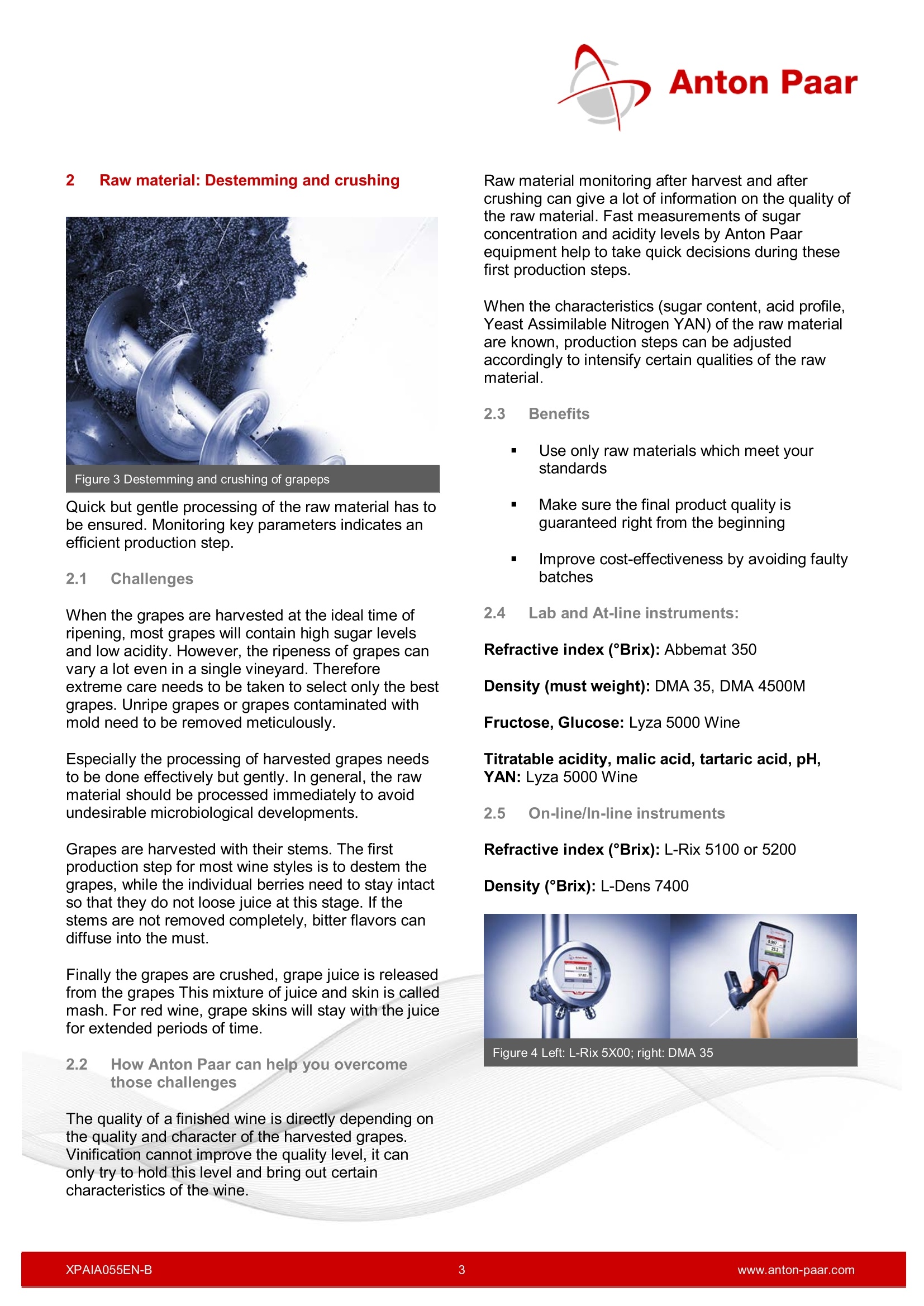
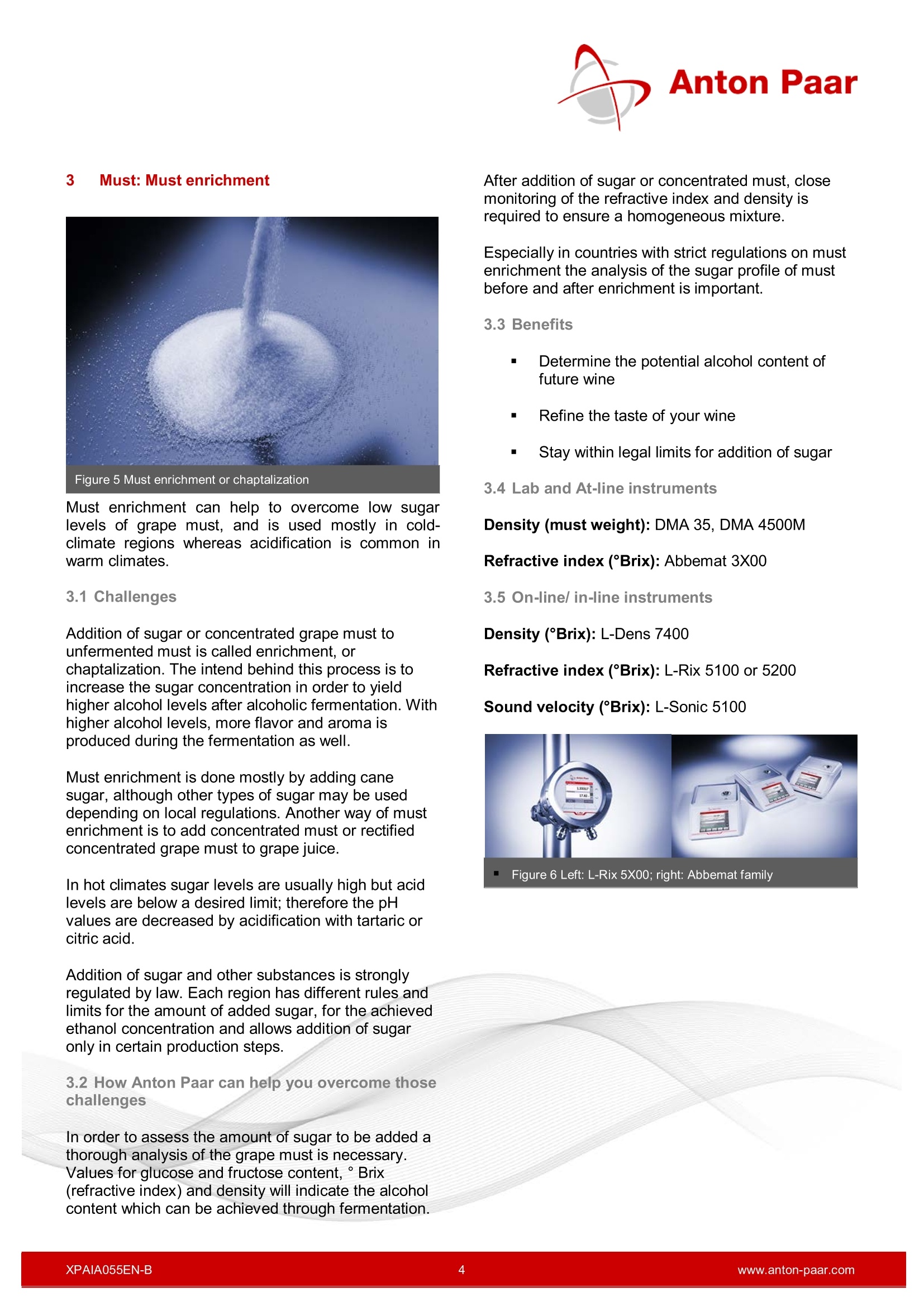

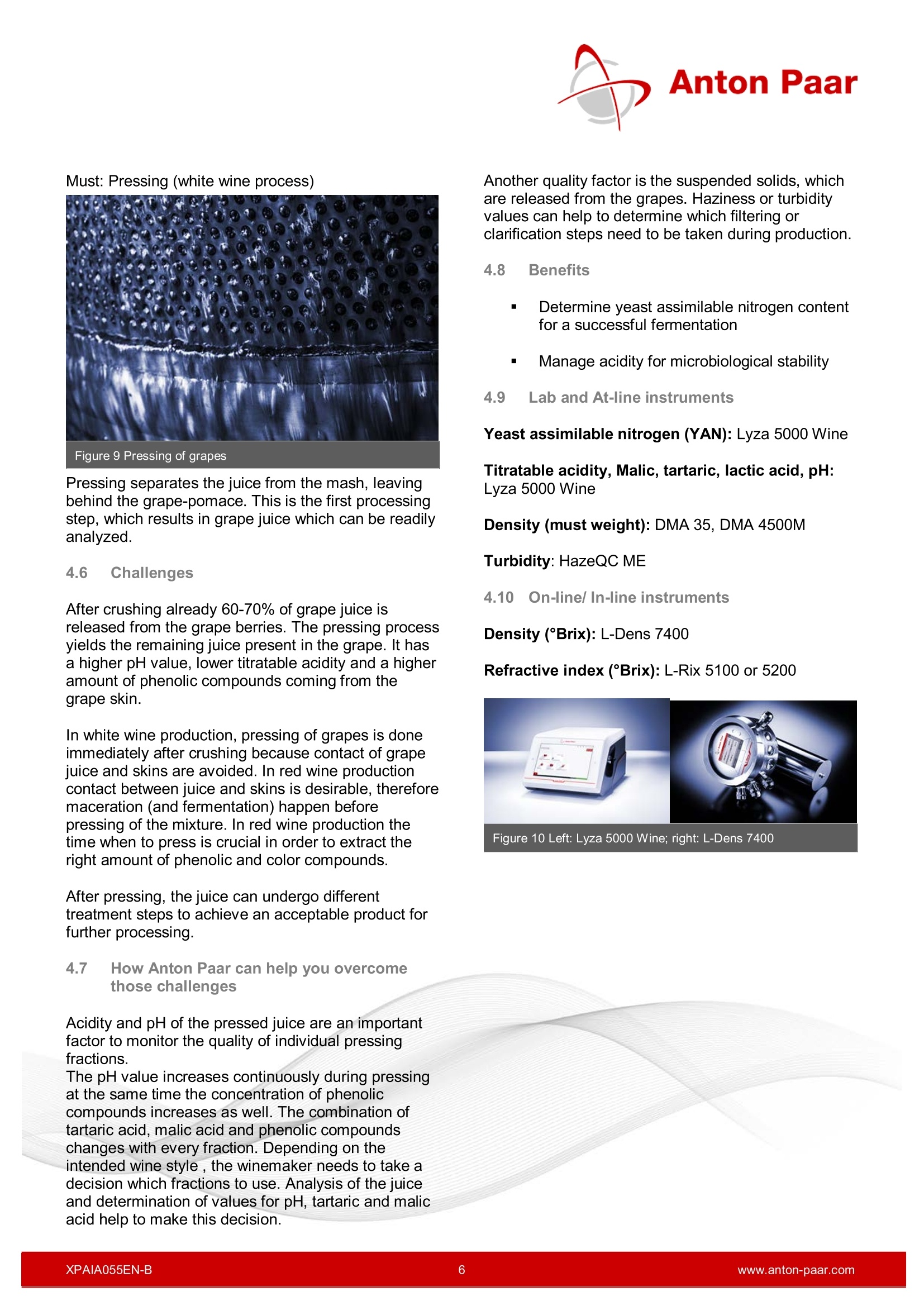

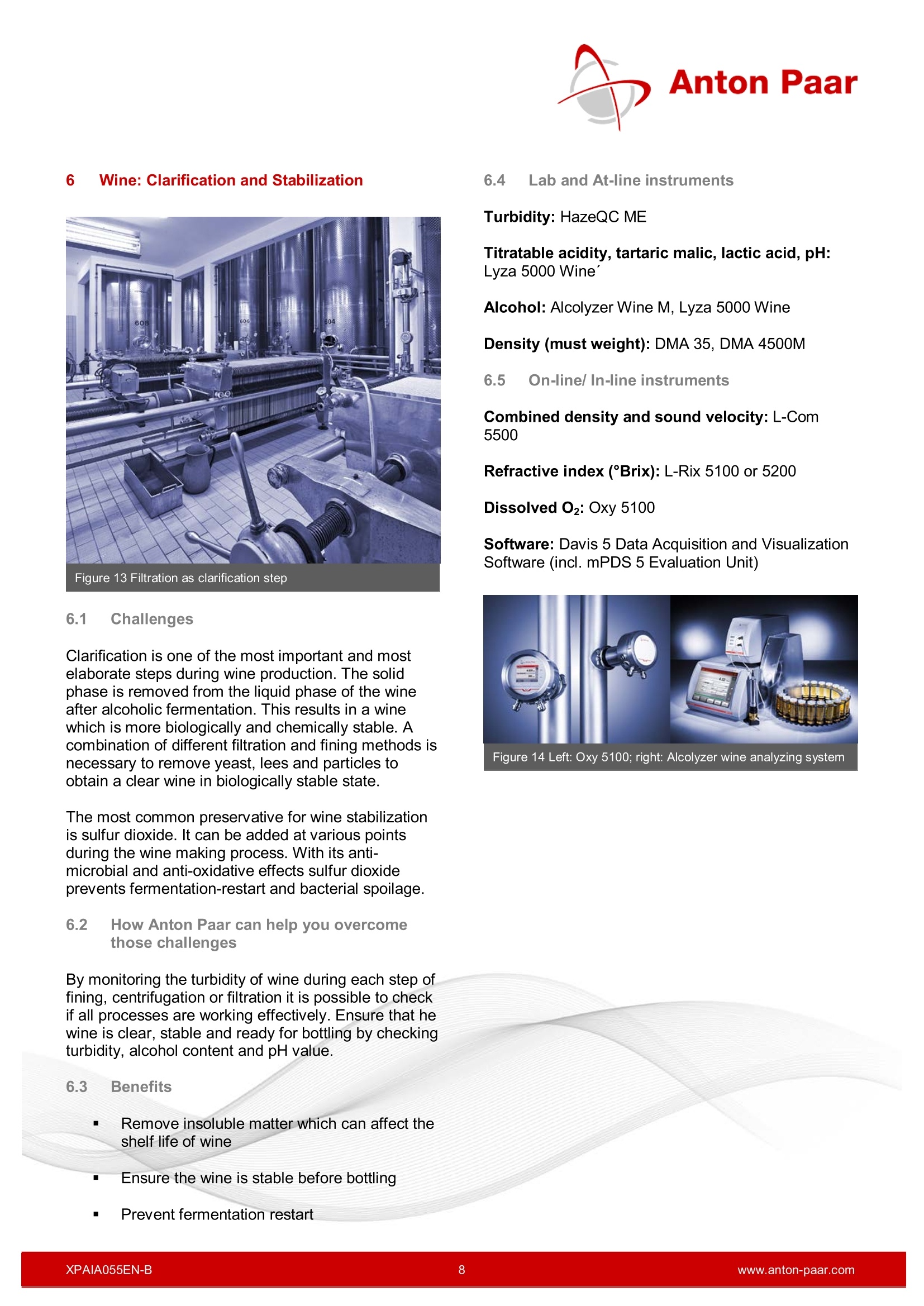
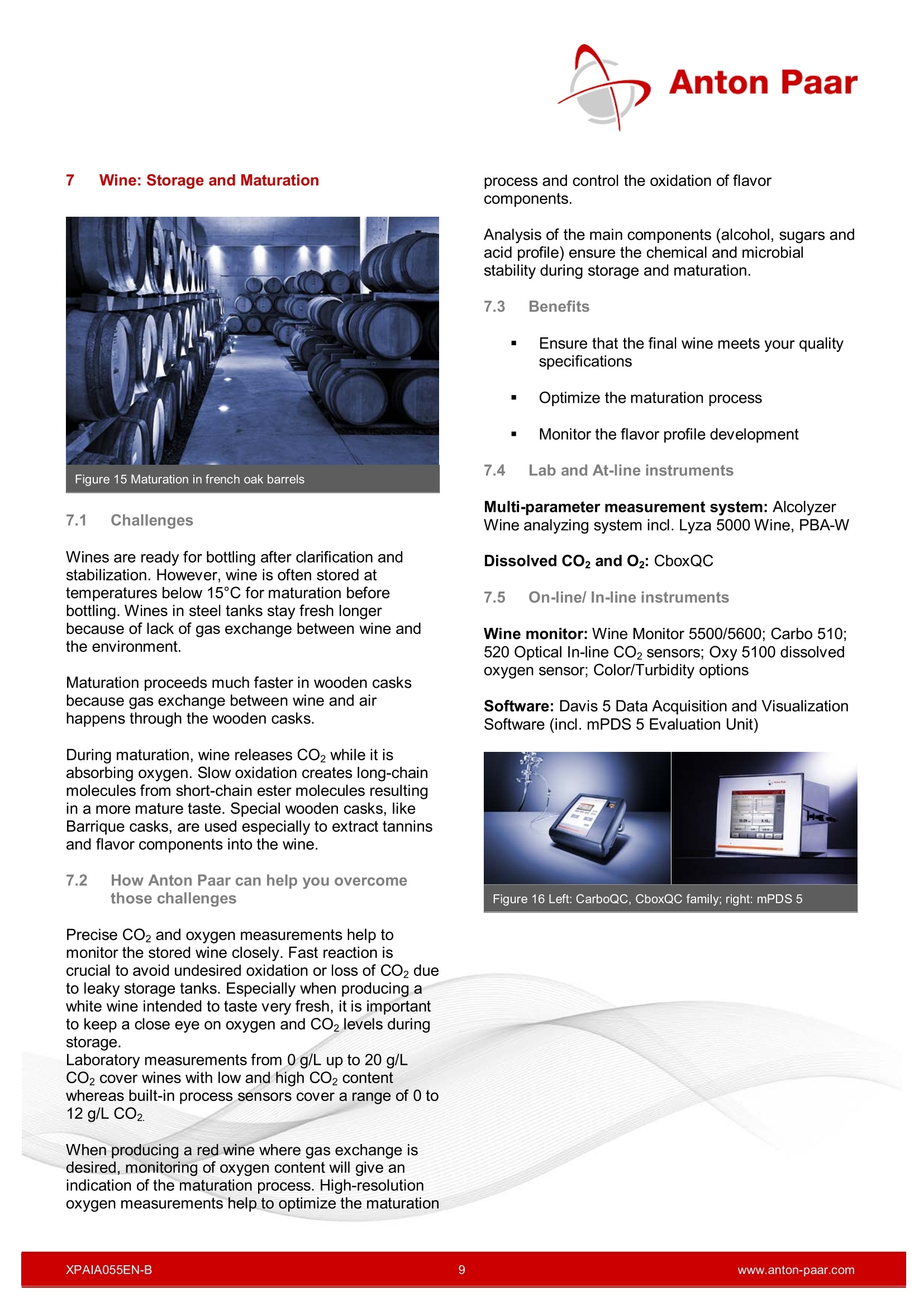
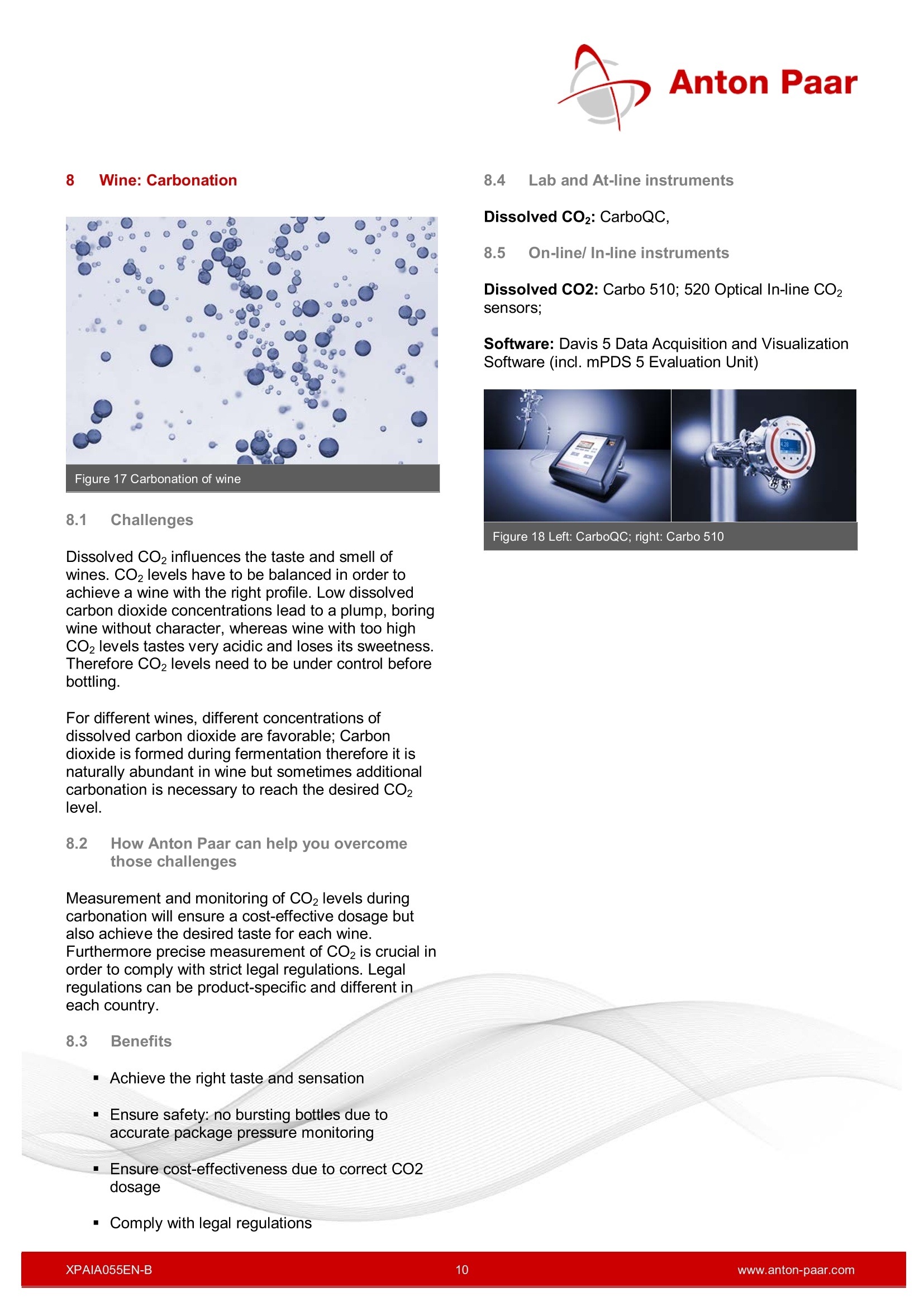
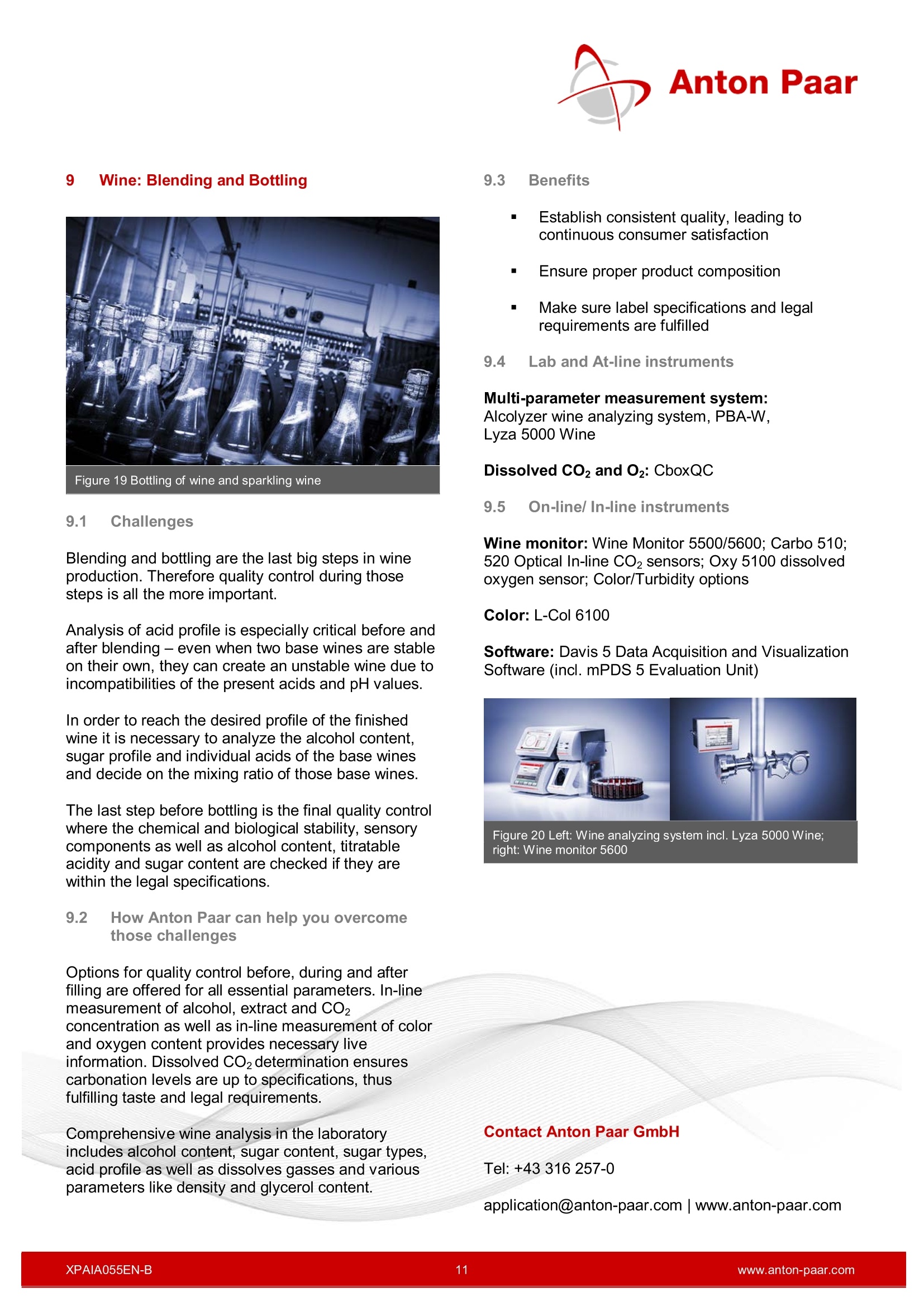
还剩9页未读,是否继续阅读?
安东帕(上海)商贸有限公司为您提供《葡萄汁中糖度、酒精度检测方案(其它工程控制)》,该方案主要用于葡萄酒及果酒中理化分析检测,参考标准--,《葡萄汁中糖度、酒精度检测方案(其它工程控制)》用到的仪器有安东帕Anton Paar在线红酒分析仪Wine monitor
推荐专场
相关方案
更多
该厂商其他方案
更多

